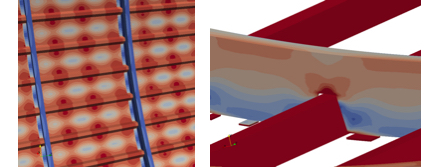
Our multi-physics parallel code Alya simulates non-linear solid mechanics for complex problems. With measured linear scalabilities in more than 100K cores, the solid mechanics module is used in several application areas: aerospace, biomedical, etc.
Summary
Alya's solids mechanics module developers and users (+10) interests are very diverse, but with a common keyword: complexity. Based in a total-Lagrangian formulation, we solve non-linear material models in dynamic large strain situations for compressible and slightly compressible solids, mostly targetting 3D elements of different orders and shapes discretized and programmed using the Finite Element Method for unstructured meshes. We also work in the development of progressive damage models, cohesive element formulation for delamination under mixed mode and low-velocity impact simulation of composites. To solve all these problems, implicit and explicit time integration schemes are used, testing all the preconditioners and solvers the Alya kernel can provide. Among the main features of the Alya solid mechanics module, we remark:
- Material models can be implemented in a very flexible way. Driven by the projects we work on, we have programmed several elastic, hyperelastic, plastic or viscoelastic materials to simulate metals, rubber, plastics, tissue, bone, etc.
- Anisotropic behaviour, usually found in composite materials or tissue.
- Crack initiation and propagation, simulated with the XFEM and Cohesize Zone Model (CZM) methods. The CZM allows to simulate delamination or interlaminar failure under mixed mode (delamination), while the XFEM method simulates crack propagation independently of the crack geometry and without the necessity of refining the mesh, therefore specially used in intralaminar cracks for composite materials (matrix failure, fibre failure and debonding).
- Progressive damage models for predicting the initiation of different constituent failure modes and uses damage evolution equations to predict the stiffness degradation of the materials until failure.
- Contact and low-velocity impact problems.
- The solids module is coupled to several other modules in Alya to solve multiphysics, notably: Fluid - Structure Interaction (FSI) for compressible and incompressible flows, thermal flow, electrhomechanical muscular activity, etc. FSI can be combined with contact to simulate valve mechanics.
Objectives
The main goal is to develop a robust, accurate and efficient solid mechanics solver which can be coupled with other Alya modules to solve complex multi-physics problems in different application areas. Among them:
- Aerospace: aircraft structures, like wings, fuselage, appendages and engines. Typical simulations require dynamic and quasi-static behaviour, FSI, damage and fracture, composites, thermo-mechanical behaviour, etc.
- Biomedical research: biomechanics at organ and tissue levels, particularly for the cardiovascular and respiratory systems. Coupled with, on one hand, action potential propagation and, on the other hand, blood flow, we simulate a fully coupled cardiac mechanics problem. Coupled throguh FSI, we simulate tissue mechanical action both for cardiovascular and respiratory system, to study issues like aneurisms rupture risk, damaged arteries, valve implants, drug delivery, etc.

